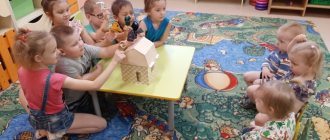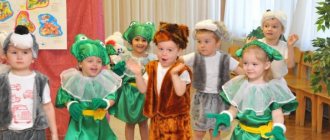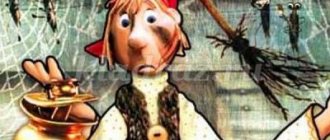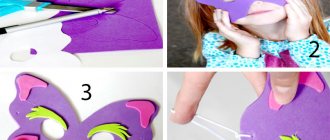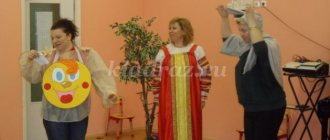Theatrical performance in kindergarten is the goal
Theatricalization is understood as one of the types of play activities used to reveal the deepest creative potential that every child has. When theatricalization, dramatic techniques are used (in other words, role-playing) and various exercises aimed at developing children's acting skills.
A lot depends on the design
For your information. The value of theatricalization lies in the fact that it helps to develop the child’s monologue and dialogic speech and, as a result, improves the level of his communicative abilities.
The theatrical performance includes the following elements:
- improving the expressiveness of characters’ lines;
- development of both active and passive vocabulary;
- work on speech development.
The corner develops thinking
In addition, the use of theatricalization pursues the following goals:
- introduce the child to the world around him;
- promote the development of creative abilities;
- develop the emotional component;
- develop an interest in reading and art;
- develop directing skills;
- learn to embody a character’s character through your own actions.
For your information . Theatrical performance is considered one of the most effective ways to introduce a child to aesthetics, culture and morality.
DIY puppet theater
To create a theater you will need a box with sides up to 10 cm high. A cookie box will do. We cover the box with colored paper using double-sided tape.
Let's start creating the curtain. The width of the curtain can be from 3 to 5 cm, the length is the size of the box. On a sheet of red velvet paper, measure the width of the curtain twice and cut off a strip. Then fold it in half, draw the outline of the curtains and cut it out. We cut the finished part along the central fold. We draw folds that imitate the drapery of a curtain with a felt-tip pen. Glue the curtain along the edges of the box.
Then we make a lambrequin. Measure 2 cm in width, draw an outline and cut it out. We measure the length of the lambrequin using the box. We cut it out, draw draperies, and glue it on top of the curtain.
Using a stationery knife, we make a slit up to 1 cm wide on the side of the box, through which the decorations will change.
Backdrops for decorations can be printed or drawn by hand. The size of the pictures must be adjusted to the internal size of the box. If the backgrounds are composed during the course of a fairy tale or play, their change will create the impression of a real theatrical action.
To make the characters you will need juice straws, double-sided tape and printed images of the characters. We fix the cut out figures on the tubes. All is ready! The show can begin.
Theater corner in kindergarten and its design
The theater corner is a component of the general atmosphere of the group, created with the aim of uniting children and developing new skills and competencies in them.
The classic theatrical corner consists of several components:
- illustrations, photographs, paintings, etc.;
- toys;
- screens (which are used as decorations, as well as curtains);
- additional props (bells, bells, cars);
- decorative elements;
- outfits and masks;
- demonstration stands;
- library sector.
Illustrations and toys are important in the corner
The theater corner should be equipped in such a way as to make theatrical activities effective.
For your information. When designing a theater corner, it is fundamentally important to take into account the age group of children, take into account the group and personal characteristics of children, their interests and aspirations.
Junior group
In nurseries and the first group of kindergarten, it is better to pay attention to finger theater. It requires dolls that fit on each child’s finger and develop fine motor skills well.
Almost any material can be used to make such dolls. It could be fabric, felt, paper, polymer clay.
The next stage, which occurs at the junior group level, is teaching children how to properly play with toys on the table surface, as well as developing finger theater skills. The task of this stage is to train the coordination of the child’s movements and further develop his fine motor skills.
For your information . In order to make such a prop yourself, you will need cones made of hard paper or cardboard. In addition, the use of bibabo (a set of glove puppets) seems advisable at this age.
Children in this age group should do:
- finger theater;
- tabletop theater;
- theater of soft and knitted toys;
- theater of toy-cones.
Middle group
Children need to hone all previously acquired skills, so classes started in previous years should not be interrupted. At the same time, it is necessary to introduce new types of theatricalization. At this stage of child development, the theater of spoons is appropriate. To “cook” the characters in the productions, ordinary plastic utensils are used here. At the same time, the theater screen began to be used.
Modeling lesson in the younger group of kindergarten
For your information . You can introduce children to dolls on the gapite. Hapit is a wooden rod. These props will help kids learn the basics of puppeteering.
During centralization classes, children in the middle group are given a more complex task. They need to bring their own movements and the plot of the production into agreement. The theater begins to represent an action that has a clear storyline and meaning. This requires the baby to reach a new level of development of coordination and motor skills.
Options for middle group children:
- finger theater;
- tabletop theater;
- dolls on gapits;
- glove puppets.
Senior kindergarten group
During training in the senior group, it is recommended to start using puppets during theatrical classes. These dolls are characterized by an unusual way of bringing them into a state of movement. A special thread holder (cross) is responsible for this process. It is to it from below that the “body” of the toy is directly attached.
In addition, special attention should be paid to the process of voicing the characters, because the goal of theatrical classes at this stage is to teach children to use vocal intonations to convey emotions.
The optimal options are:
- finger theater;
- glove puppets;
- puppets.
In the preparatory group
At this stage, the child already becomes a “real” actor. He must transform into his hero by reproducing his manner of moving, speaking, and behaving. The child must learn to imitate the voice and correctly express the emotions and experiences of the hero. For a more accurate and real transformation, children dress up in stage costumes.
Life-size puppets develop well
At this age, it is possible to use a wide range of props, for example:
- finger puppets;
- changelings;
- glove puppets;
- puppets;
- life-size puppets;
- cane dolls.
At the same time, it is worth taking into account a certain convention of the above distribution of activities in the theater club depending on the age group of the child.
For your information. It is necessary to take into account the general level of the group, the specifics of the child, and the presence of interest in a certain type of theatrical activity.
It is a completely normal practice for children of middle and senior age to participate in costume performances. Glove puppets can be successfully used in theatrical performances even for children 5–6 years old.
Cardboard theater
An ordinary cardboard shoe box will become magical if you decorate it with fabric, secure it in the form of a curtain, and place a picture based on the plot of a fairy tale on the backdrop. You can make the decorations yourself: print or draw a chair, a chair, a table, a magic castle or a hut.
Cut a hole in the bottom of the box and attach ribbon to the side walls. Such a theater can be hung on your neck, then it will be very convenient to show scenes from figures attached to wooden skewers.
The characters are simply cut out of paper, and the manufacturing process itself is an act of improvised theater. The child can try himself as a costume designer and artist, choosing characters and scenery or a director, changing the plot at will.
Make little characters to put on your fingers. This is a very fun activity for a child.
How to make a theater corner passport
The theatrical corner, or rather, its design, must be carried out in accordance with federal state educational standards (abbreviated as Federal State Educational Standards). Designing a theater corner in a kindergarten according to the Federal State Educational Standard requires compliance with certain standards.
The Federal State Educational Standard prescribes that the theatrical corner should provide:
- development of abilities to remember information;
- development of the child’s thought processes;
- development of sociocultural concepts in children;
- strengthening speech capabilities;
- physiological development;
- introduction to a culture of behavior in society;
- knowing yourself as a person.
The passport according to the Federal State Educational Standard includes eight positions. At the same time, the standard provides a detailed description of each of them:
- The inscription of the full name of the child care institution.
- Designation of the group and name of the theatrical corner.
- The authors who designed the corner.
- Name and description of zones that are part of the project. Mandatory elements are a screen and a wardrobe. Zoning of other parts occurs at the discretion of competent persons. In total, we can highlight a costume room, a dressing room, a workshop, an auditorium, a library (including the availability of video and audio materials), a screen, cabinets for storing props, and an area dedicated to the results and achievements of children in the field of theatrical performance (stand).
- Occupancy of each of the existing zones.
- Age indicators of pupils.
- A list of activities that are implemented at a specific age stage during theatrical classes.
- Various methodological developments, recommendations, templates and presentations. They mean advice regarding the frequency of appropriate activities and their duration. It also includes tasks assigned to a specific group, a list of exercises that are required to be performed during theatrical classes for representatives of a specific group.
Sound culture of speech in the second junior group
Festive and carnival toys
For children under two years old you need:
- To participate in festive matinees and entertainment: carnival hats (bunnies, birds, kittens, bears, chickens and other characters). For festive decoration of the group and area - inflatable film balls (balls), funny figurative figures, flags and garlands of medium and large size. The materials for them can be paper, film, lightweight fabrics and non-woven materials.
Ready-made Christmas tree decorations for this group are selected from unbreakable, lightweight materials: multi-colored, small-sized balls, bells, snowflakes.
For children from two to four years old, in addition to carnival hats, you need ready-made half masks (bunny, bear, kitten, cockerel), made of paper, thin cardboard, papier-mâché (impregnated against fire).
Ready-made Christmas tree decorations can be different in shape, design, and material.
Semi-finished products are also needed for the manufacture of homemade Christmas tree decorations using film, paper, fabric (for flags, garlands), as well as natural materials (walnut shells, cones, acorns, branches, etc.).
Children from four to six years old can be offered large inflatable dolls, animal figures, fairy-tale characters that are easy to carry, all kinds of wands, and emblems.
Festive and carnival toys can be very large and decorative. Surprise toys with effects that imitate fireworks (without the use of fire or flammable materials) are interesting. The attributes of costumes and masks should be created in accordance with the anthropometric and ergonomic data of the children of each group.
